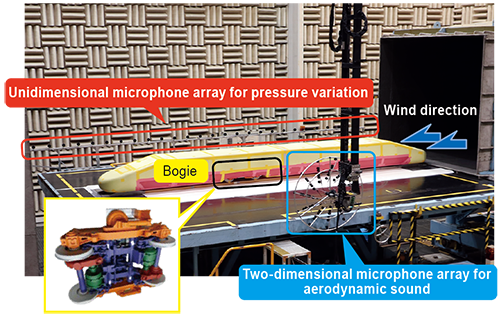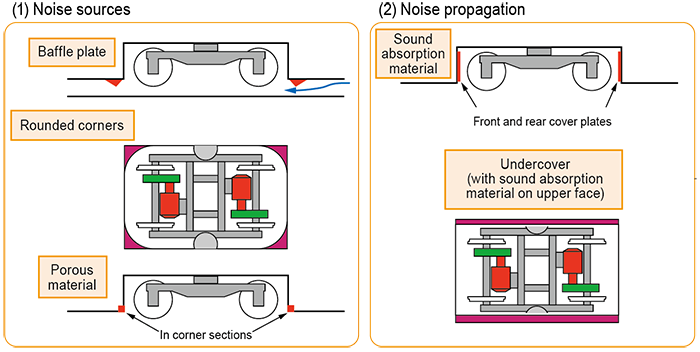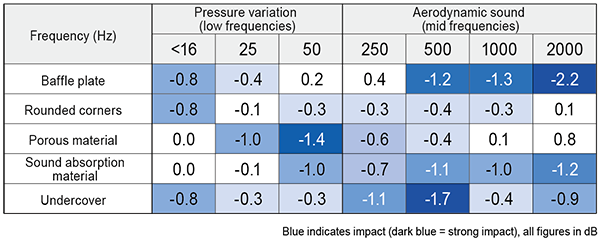26. Reducing aerodynamic noise and pressure fluctuation from bogies on high-speed trains
Reducing both noise and low-frequency pressure fluctuation on open sections is key to improving amenity in the vicinity of rail lines. Noise generated by high-speed trains can be broken down into a number of constituent elements: wheel noise, noise from structures such as bridges, and aerodynamic sound from train bogies, which is the single largest noise source. Past research has shown that bogies are also the primary source of pressure fluctuation from passing trains. We developed several strategies for mitigating both aerodynamic sound and pressure fluctuation from bogies on high-speed trains, and used wind tunnel tests to validate their efficacy (see Figure 1).
We adopted a two-pronged approach to reducing aerodynamic sound and pressure fluctuation: (1) keep internal parts of the bogie away from high-speed airflows, and (2) suppress noise propagation by adding sound insulating materials inside the bogie storage area to mitigate multipath sound reflection. We conducted a series of wind tunnel tests to assess the efficacy of different strategies in reducing aerodynamic sound and pressure fluctuation (see Figure 2). Table 1 shows how the cumulative effect of multiple strategies used in combination reduces pressure fluctuation and aerodynamic sound at key frequencies. In relation to rounding of corners, considered the most easily applicable solution, we measured noise and pressure fluctuation levels on an operational train where the railway operator had already done something similar, and we found that this had proven effective.
In the future, we plan to conduct running tests on low-noise train models and use our findings to inform the development of enhanced practical solutions suitable for deployment on commercial train services.
Other Contents
- 22. High-efficiency generator design for diesel electric cars
- 23. Driver advisory system for long-distance trains by speed transition estimation
- 24. Energy-saving driving operation to minimize the energy consumption during small scale delays
- 25. Modular sound insulating barriers designed to replace existing noise barriers on viaducts
- 26. Reducing aerodynamic noise and pressure fluctuation from bogies on high-speed trains
- 22. High-efficiency generator design for diesel electric cars
- 23. Driver advisory system for long-distance trains by speed transition estimation
- 24. Energy-saving driving operation to minimize the energy consumption during small scale delays
- 25. Modular sound insulating barriers designed to replace existing noise barriers on viaducts
- 26. Reducing aerodynamic noise and pressure fluctuation from bogies on high-speed trains



